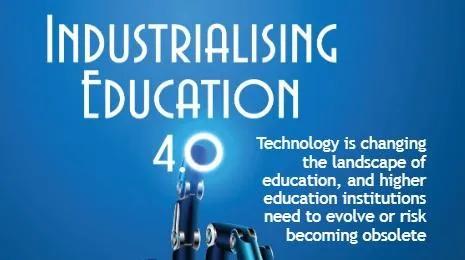Industrialising Education 4.0
Digitalisation is transforming the values and domains of existing industries. Technological advances as driven by the Fourth Industrial Revolution (IR 4.0) are evolving at an incredibly fast rate, revamping the way we live, work and function as a society. Emerging from the digital evolution is Education 4.0, a new educational model that was developed in response to IR 4.0.
Within the local context, the advent of Education 4.0 has prompted Malaysia’s Ministry of Higher Education (MOHE) to establish initiatives adopting 21st-century pedagogies and skills. MOHE has framed the implementation parameters of Education 4.0 to include the redesign of learning spaces, and an overhaul of pedagogies to include neoteric teaching and learning dimensions such as heutagogy (self-determined learning), paragogy (peer-oriented learning) and cybergogy (virtual-based learning).
Curriculum design is further configured to be fluid and organic, and industry-relevant programmes are to be offered to prepare students for future industry demands.
MOHE’s trajectory towards Education 4.0 may pose both opportunities and challenges. Among the questions raised include: “Can we keep up with the fast-paced changes in technology?”, “Can our education system be radically transformed to meet the demands necessitated by IR 4.0?” and “Do we have sufficient experts and financial support to facilitate and administer new technology?”
These questions are important in assessing the possibility, or impossibility, of executing Education 4.0 initiatives in the educational sector.
Digital education with modern learning technologies such as augmented reality, virtual reality and artificial intelligence is indeed costly to implement. In hastening the digitisation process, we may broaden the existing connectivity gap that has emerged from the lack of digital infrastructure, literacy and funding. Statistics have further shown that, as of January 2018, more than 4 billion people around the world still have limited to no access to the Internet.
Will the digital chasm render Education 4.0 initiatives futile? Not necessarily. For one, the benefits of technology in education are undeniable. Technology has inspired various teaching approaches that motivate not only students in their learning but also educators in their teaching.
Examples of these modern approaches include online game-based learning and assessment, online learning and blended classrooms, mobile and device-based learning and the use of instructional tools such as Interactive Whiteboards and Student Response Systems.
The universal, almost necessary, Internet use in today’s society can also support face-to-face teaching and learning approaches, where educators can capitalise on social media and new media tools such as podcasts to make learning more current.
The spread of Web 4.0 has further contributed to the viability of technology as part of classroom instructional strategies. This means the ‘web of intelligence connections’ of Web 4.0 will see a more interdependent relationship between humans and machines through the use of artificial intelligence, 3D printers and holograms, among other highly advanced technologies.
Teaching in the age of IR 4.0 is thus all about challenging the norm and pushing boundaries. Higher education institutions can embrace a few methods to adopt technology as part of their instructional strategies.
First, higher education institutions can streamline blended learning and mix different teaching processes. Both can be achieved with the use of technologies to complement face-to-face knowledge acquisition. Learning is enhanced when students are given in-class opportunities to apply the information they have acquired using online activities, combined with synchronous or asynchronous communication components that are individualised and self-paced.
Second, they can introduce new courses that align with the skills demanded by IR 4.0. Examples of such courses include data analytics, big data, cyber-physical system technologies (artificial intelligence and robotics), digital economy and technopreneurship.
Third, they can initiate Massive Open Online Courses (MOOCs) such as Coursera, Udacity, Udemy and edX within the teaching and learning environment. MOOCs can be adopted as a solution to classroom unproductivity or overcrowding through the use of an open-sourced content system (where anyone can help build, change or edit content). MOOCs can be accessed for free as an off-campus, online teaching and learning model.
Finally, they can cultivate innovative talent through knowledge-based and interdisciplinary training. Training that is customised and informed with data can help produce future scientists and technologists who can cater to fast-changing industry needs.
In sustaining and improving their role in shaping the future, higher education institutions are the ultimate test beds for new teaching and learning innovations. The future of education needs to be both physically and virtually immersive to prime 21st-century learners for the highly industrialised digital nation.
Dr Malissa Mahmud
Centre for English Language Studies
@email
This article was first published in Spotlight on Teaching (Volume 1)




